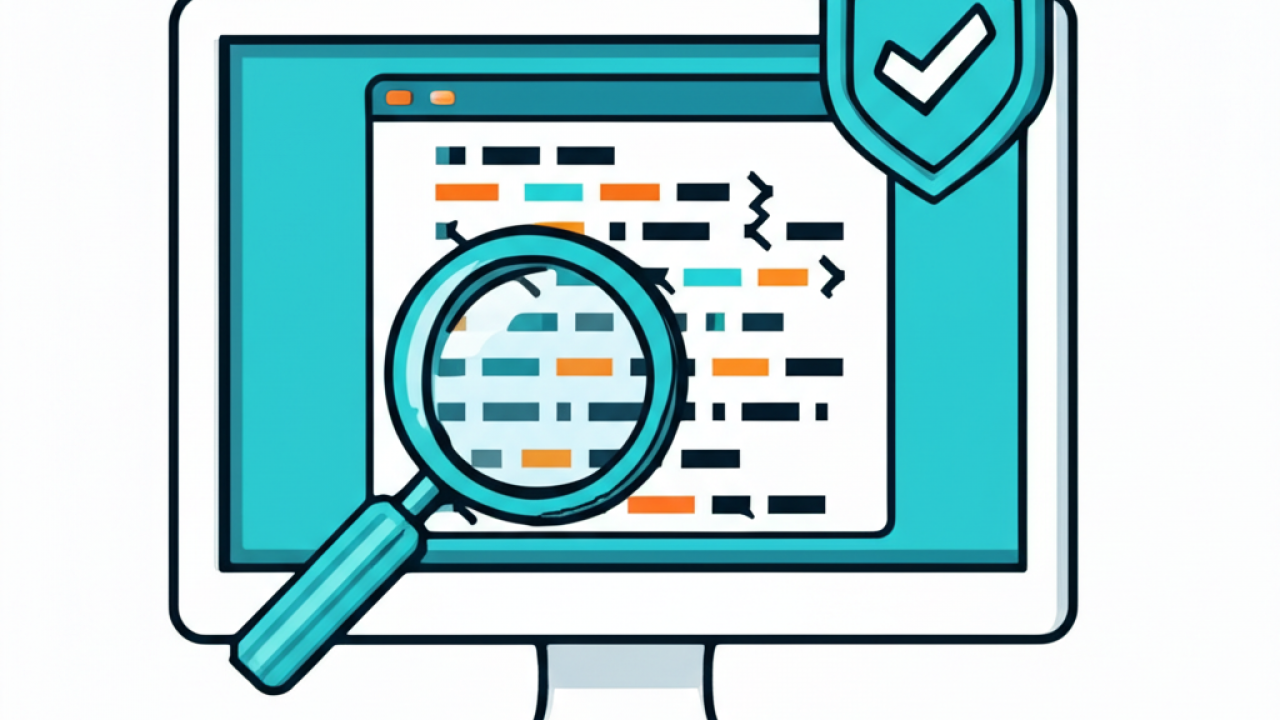If you’ve spent any time in software development, you’ve probably lived this moment: a frantic, last-minute security report lands on your desk right before a major release. Suddenly, everyone’s scrambling to patch a vulnerability that’s been lurking in the codebase for months. It’s frustrating, expensive, and completely derails your roadmap. This is where learning what is sast can change the game.
SAST, or Static Application Security Testing, is a fancy way of saying “checking your code for security holes without actually running it.” Think of it like a super-powered linter, but instead of nagging you about comma placement, it warns you about potential SQL injection flaws or hardcoded API keys. It’s a core practice of “shifting left”—finding and fixing problems early in the development lifecycle, when they’re cheap and easy to solve.
How SAST Actually Works
It sounds a bit like magic, right? How can a tool find complex vulnerabilities just by reading code? It’s less magic and more clever computer science.
At its core, a SAST tool does a few things:
1- It parses your code. The tool reads your source code (or sometimes compiled binaries) and builds an internal representation of it. This isn’t just text; it’s a structured model of your application’s logic, like an Abstract Syntax Tree (AST) or a Control Flow Graph (CFG). Think of it as creating a detailed blueprint of your application.
2 – It applies rules. The tool then runs a set of rules or queries against this blueprint. These rules are designed to spot known bad patterns. For example, a rule might look for a path where user-controlled input (like request.query.name) flows directly into a database query string without being sanitized. That’s a classic SQL injection pattern.
3- It reports the findings. When a rule matches, the tool flags it as a potential vulnerability. A good report will tell you exactly what the issue is, where it is (file and line number), how severe it is, and sometimes even suggest how to fix it.
The entire process is “static” because the code isn’t executing. It’s being analyzed at rest, which is why you can run it so early and often.
Why SAST Is a Developer’s Best Friend
Let’s get straight to it. Security can sometimes feel like a tax on development—another department, another process slowing you down. But good SAST tooling, when used correctly, is the opposite. It’s a force multiplier for developers.
So, Really, What is SAST’s Big Payoff?
➤ Find bugs when they’re cheap. A vulnerability found in your IDE takes minutes to fix. The same bug found in production by a penetration test can cost thousands of dollars and days of engineering time to triage, patch, test, and deploy. The ROI here is massive.
➤ It makes you a better developer. Seriously. SAST tools are like having a senior security engineer pair-programming with you 24/7. You’ll start to recognize anti-patterns and learn to write more secure code by default. It’s an incredible educational feedback loop.
➤ Ship with confidence. Integrating SAST into your CI/CD pipeline acts as a safety net. It reduces the dread of security reviews and gives you confidence that you’re not shipping obvious, preventable vulnerabilities.
➤ It helps with compliance. For many industries (finance, healthcare, government), security scanning isn’t just a good idea; it’s a requirement. SAST helps you check those boxes for standards like PCI-DSS, HIPAA, and SOC 2.
Common Flaws SAST Is Great at Finding
SAST tools excel at finding vulnerabilities that can be identified by analyzing code paths and data flow. Here are some of the usual suspects:
– Injection Flaws: The OWASP Top 10 classic. This includes SQL injection, Command injection, and LDAP injection, where user input is improperly trusted and executed.
– Cross-Site Scripting (XSS): When your application accidentally lets an attacker’s malicious script run in another user’s browser.
– Hardcoded Secrets: API keys, passwords, and private certificates checked directly into source control. We’ve all seen it (and maybe done it). SAST is your seatbelt.
– Insecure Configurations: Things like leaving debug mode enabled, using default credentials, or having overly permissive cross-origin resource sharing (CORS) policies.
– Memory Management Issues: For languages like C and C++, SAST is a lifesaver for finding buffer overflows, use-after-free bugs, and memory leaks.
Getting SAST into Your Daily Workflow
The best security tool is one that developers actually use. And developers will only use tools that fit seamlessly into their existing workflow. The goal is to make security feedback as fast and frictionless as linting feedback.
Here’s how you can weave SAST into the software development lifecycle (SDLC), from your laptop to production:
1. In your IDE: This is the holy grail. A SAST plugin that provides real-time feedback as you write code is the fastest feedback loop possible. You see a problem, you fix it, you move on.
2. As a pre-commit hook: A great last line of defense before your code even gets pushed. Run a quick, targeted scan on the files you’ve changed. This prevents bad code from ever hitting the team’s repository.
3. In the CI/CD pipeline: This is the non-negotiable, team-wide safety net. Every pull request or merge request should trigger a SAST scan. You can configure it to fail the build if critical vulnerabilities are found, effectively creating a quality gate for security.
4. On a schedule: For full-repo analysis, you can run deeper, more time-consuming scans on a nightly or weekly basis. This is great for finding issues in older parts of the codebase that aren’t actively being worked on.
Let’s Be Real: The Downsides of SAST
I love SAST, but it’s not a silver bullet. If anyone tells you their tool finds everything with perfect accuracy, they’re selling you something. Being aware of the limitations is key to using it effectively.
The biggest challenge? False positives.
A SAST tool might flag a piece of code that *looks* like a vulnerability but is actually safe. Why? Because it lacks runtime context. It doesn’t know what data will *actually* be passed into a function in production. It can’t understand the intent behind your business logic.
This leads to noise. Too much noise, and developers will start ignoring the results altogether. A SAST tool that’s 70% accurate and integrated into your workflow is infinitely more valuable than a 99% accurate tool that’s so noisy you turn it off.
- False Negatives: The opposite problem. The tool misses a real vulnerability. This often happens with complex, logic-based flaws that require understanding the application’s purpose.
- Configuration Overhead: Getting a SAST tool “just right” takes effort. You need to tune the rules, ignore irrelevant findings for your project, and integrate it into your specific build process.
- Language Support: A tool that’s amazing for Java might be mediocre for Python or have zero support for a new language like Zig or Rust.
SAST and Its Friends: The AppSec Alphabet Soup
SAST is just one tool in a complete application security toolkit. Understanding how it differs from its cousins is crucial.
Think of it like inspecting a building:
➤ SAST (Static Testing) is like reading the blueprints. You’re looking for design flaws, weak points, and code that doesn’t meet spec, all before the building is even constructed.
➤ DAST (Dynamic Testing) is like hiring an inspector to try and break into the finished building. It attacks the running application from the outside, sending malicious payloads and looking for weaknesses without any knowledge of the internal code.
➤ SCA (Software Composition Analysis) is like checking the supplier list for all the materials. It looks at your open-source dependencies (your package.json or pom.xml) and alerts you if you’re using a component with a known, published vulnerability (a CVE).
➤ IAST (Interactive Testing) is like putting sensors inside the walls while the building is in use. It instruments the running application to watch how data flows in real-time, combining the “inside view” of SAST with the “runtime view” of DAST.
The modern approach isn’t SAST vs. DAST vs. SCA. It’s SAST + DAST + SCA. They are complementary, each finding different types of issues.
How to Make SAST Actually Work for You
You’re sold on the idea. Now what? Rolling out a SAST program can be daunting. Here are the keys to making it successful and avoiding the common pitfalls.
→ Start early, scan often. The mantra of shift-left. The earlier you find an issue, the better. Make scanning a frequent, automated part of your process.
→ Tune the damn thing. This is the most important step. Out of the box, your first scan on a mature codebase might return thousands of issues. It’s overwhelming. Your first job is not to fix the bugs, but to fix the tool. Aggressively tune the rules, turn off entire categories that aren’t relevant, and teach the tool what’s important to *you*.
→ Prioritize ruthlessly. Don’t treat all findings as equal. Focus on the truly critical and high-severity vulnerabilities first. Is it in internet-facing code? Is it an injection flaw? Fix that. A low-severity issue in an internal admin tool can wait.
→ Integrate, don’t isolate. Don’t make developers log into a separate, clunky security dashboard. Pipe the results directly into the tools they already use: pull requests, Slack notifications, IDE plugins. Reduce friction at all costs.
→ Educate, don’t dictate. A report that just says “XSS on line 50” isn’t helpful. Good tools provide context, explain *why* it’s a vulnerability, and offer clear examples of how to fix it. Use the tool as a teaching moment for the whole team.
The Takeaway
Static Application Security Testing (SAST) is no longer a “nice to have” for niche, high-security applications. It’s a fundamental practice for any modern software team that wants to build secure, reliable products without slowing down.
It’s not a magic wand that eliminates all risk, but it is an incredibly powerful safety net that empowers developers to find and fix entire classes of vulnerabilities before they ever become a problem. By integrating it thoughtfully into your workflow, you can move faster, with more confidence, and build better software.



